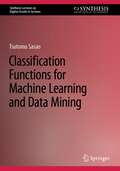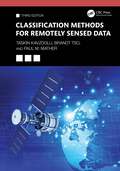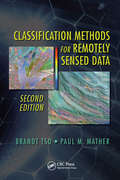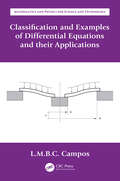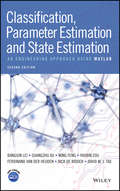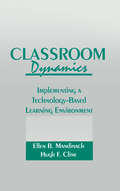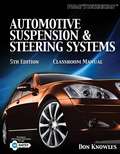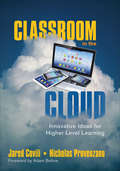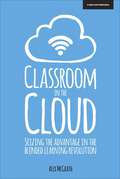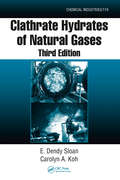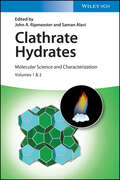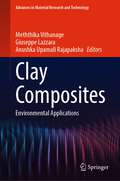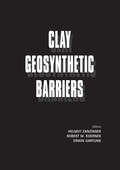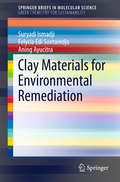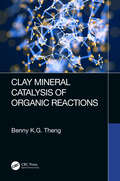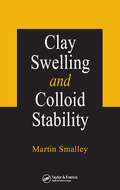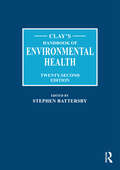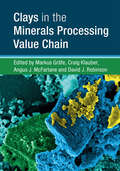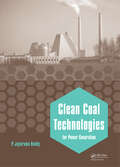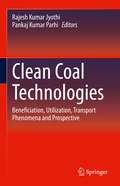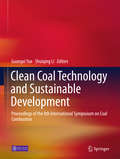- Table View
- List View
Classification Functions for Machine Learning and Data Mining (Synthesis Lectures on Digital Circuits & Systems)
by Tsutomu SasaoThis book introduces a novel perspective on machine learning, offering distinct advantages over neural network-based techniques. This approach boasts a reduced hardware requirement, lower power consumption, and enhanced interpretability. The applications of this approach encompass high-speed classifications, including packet classification, network intrusion detection, and exotic particle detection in high-energy physics. Moreover, it finds utility in medical diagnosis scenarios characterized by small training sets and imbalanced data. The resulting rule generated by this method can be implemented either in software or hardware. In the case of hardware implementation, circuit design can employ look-up tables (memory), rather than threshold gates.The methodology described in this book involves extracting a set of rules from a training set, composed of categorical variable vectors and their corresponding classes. Unnecessary variables are eliminated, and the rules are simplified before being transformed into a sum-of-products (SOP) form. The resulting SOP exhibits the ability to generalize and predict outputs for new inputs. The effectiveness of this approach is demonstrated through numerous examples and experimental results using the University of California-Irvine (UCI) dataset.This book is primarily intended for graduate students and researchers in the fields of logic synthesis, machine learning, and data mining. It assumes a foundational understanding of logic synthesis, while familiarity with linear algebra and statistics would be beneficial for readers.
Classification Methods for Internet Applications (Studies in Big Data #69)
by Martin Holeňa Petr Pulc Martin KoppThis book explores internet applications in which a crucial role is played by classification, such as spam filtering, recommender systems, malware detection, intrusion detection and sentiment analysis. It explains how such classification problems can be solved using various statistical and machine learning methods, including K nearest neighbours, Bayesian classifiers, the logit method, discriminant analysis, several kinds of artificial neural networks, support vector machines, classification trees and other kinds of rule-based methods, as well as random forests and other kinds of classifier ensembles. The book covers a wide range of available classification methods and their variants, not only those that have already been used in the considered kinds of applications, but also those that have the potential to be used in them in the future. The book is a valuable resource for post-graduate students and professionals alike.
Classification Methods for Remotely Sensed Data
by Paul M. Mather Taskin Kavzoglu Brandt TsoThe third edition of the bestselling Classification Methods for Remotely Sensed Data covers current state-of-the-art machine learning algorithms and developments in the analysis of remotely sensed data. This book is thoroughly updated to meet the needs of readers today and provides six new chapters on deep learning, feature extraction and selection, multisource image fusion, hyperparameter optimization, accuracy assessment with model explainability, and object-based image analysis, which is relatively a new paradigm in image processing and classification. It presents new AI-based analysis tools and metrics together with ongoing debates on accuracy assessment strategies and XAI methods.New in this edition: Provides comprehensive background on the theory of deep learning and its application to remote sensing data. Includes a chapter on hyperparameter optimization techniques to guarantee the highest performance in classification applications. Outlines the latest strategies and accuracy measures in accuracy assessment and summarizes accuracy metrics and assessment strategies. Discusses the methods used for explaining inherent structures and weighing the features of ML and AI algorithms that are critical for explaining the robustness of the models. This book is intended for industry professionals, researchers, academics, and graduate students who want a thorough and up-to-date guide to the many and varied techniques of image classification applied in the fields of geography, geospatial and earth sciences, electronic and computer science, environmental engineering, etc.
Classification Methods for Remotely Sensed Data
by Paul Mather Brandt TsoSince the publishing of the first edition of Classification Methods for Remotely Sensed Data in 2001, the field of pattern recognition has expanded in many new directions that make use of new technologies to capture data and more powerful computers to mine and process it. What seemed visionary but a decade ago is now being put to use and refined in
Classification and Examples of Differential Equations and their Applications (Mathematics and Physics for Science and Technology)
by Luis Manuel Braga da Costa CamposClassification and Examples of Differential Equations and their Applications is the sixth book within Ordinary Differential Equations with Applications to Trajectories and Vibrations, Six-volume Set. As a set, they are the fourth volume in the series Mathematics and Physics Applied to Science and Technology. This sixth book consists of one chapter (chapter 10 of the set). It contains 20 examples related to the preceding five books and chapters 1 to 9 of the set. It includes two recollections: the first with a classification of differential equations into 500 standards and the second with a list of 500 applications. The ordinary differential equations are classified in 500 standards concerning methods of solution and related properties, including: (i) linear differential equations with constant or homogeneous coefficients and finite difference equations; (ii) linear and non-linear single differential equations and simultaneous systems; (iii) existence, unicity and other properties; (iv) derivation of general, particular, special, analytic, regular, irregular, and normal integrals; (v) linear differential equations with variable coefficients including known and new special functions. The theory of differential equations is applied to the detailed solution of 500 physical and engineering problems including: (i) one- and multidimensional oscillators, with damping or amplification, with non-resonant or resonant forcing; (ii) single, non-linear, and parametric resonance; (iii) bifurcations and chaotic dynamical systems; (iv) longitudinal and transversal deformations and buckling of bars, beams, and plates; (v) trajectories of particles; (vi) oscillations and waves in non-uniform media, ducts, and wave guides. Provides detailed solution of examples of differential equations of the types covered in tomes l-5 of the set (Ordinary Differential Equations with Applications to Trajectories and Vibrations, Six -volume Set) Includes physical and engineering problems that extend those presented in the tomes 1-6 (Ordinary Differential Equations with Applications to Trajectories and Vibrations, Six-volume Set) Includes a classification of ordinary differential equations and their properties into 500 standards that can serve as a look-up table of methods of solution Covers a recollection of 500 physical and engineering problems and sub-cases that involve the solution of differential equations Presents the problems used as examples including formulation, solution, and interpretation of results
Classification, Parameter Estimation and State Estimation: An Engineering Approach Using MATLAB
by Bangjun Lei David M. Tax Dick De Ridder Ferdinand van der Heijden Guangzhu Xu Ming Feng Yaobin ZouA practical introduction to intelligent computer vision theory, design, implementation, and technology The past decade has witnessed epic growth in image processing and intelligent computer vision technology. Advancements in machine learning methods—especially among adaboost varieties and particle filtering methods—have made machine learning in intelligent computer vision more accurate and reliable than ever before. The need for expert coverage of the state of the art in this burgeoning field has never been greater, and this book satisfies that need. Fully updated and extensively revised, this 2nd Edition of the popular guide provides designers, data analysts, researchers and advanced post-graduates with a fundamental yet wholly practical introduction to intelligent computer vision. The authors walk you through the basics of computer vision, past and present, and they explore the more subtle intricacies of intelligent computer vision, with an emphasis on intelligent measurement systems. Using many timely, real-world examples, they explain and vividly demonstrate the latest developments in image and video processing techniques and technologies for machine learning in computer vision systems, including: PRTools5 software for MATLAB—especially the latest representation and generalization software toolbox for PRTools5 Machine learning applications for computer vision, with detailed discussions of contemporary state estimation techniques vs older content of particle filter methods The latest techniques for classification and supervised learning, with an emphasis on Neural Network, Genetic State Estimation and other particle filter and AI state estimation methods All new coverage of the Adaboost and its implementation in PRTools5. A valuable working resource for professionals and an excellent introduction for advanced-level students, this 2nd Edition features a wealth of illustrative examples, ranging from basic techniques to advanced intelligent computer vision system implementations. Additional examples and tutorials, as well as a question and solution forum, can be found on a companion website.
Classroom Dynamics: Implementing a Technology-Based Learning Environment
by Ellen B. Mandinach Hugh F. ClineThis book reports an attempt to introduce change in schools using a computer-based curriculum innovation for teaching higher-order thinking skills to middle and high school students. One of the volume's themes is the extraordinary complexity and difficulty of facilitating such change in schools. A corollary of that theme is the fact that patience must be an integral part of the strategy when promoting or studying change in schools. In reporting the activities during the early years of a technological innovation and research project in which the emphasis thus far has been primarily on establishing the change, this book focuses on describing the move to a technology-based learning environment. As such, it details an ongoing process -- a fascinating process -- and one that is likely to be repeated in the near future in countless schools throughout the nation.
Classroom in the Cloud: Innovative Ideas for Higher Level Learning
by Jared Covili Nicholas ProvenzanoThe sky’s not the limit anymore—get your head in the cloud! Making the most of the digital age in education just got easier. With cloud computing, students can connect with teachers, educators can connect with colleagues, and opportunities for meaningful collaboration can grow exponentially. In this easy-to-use primer, the author of bestseller Going Google teams up with Twitter’s The Nerdy Teacher to demonstrate what cloud-based instruction can mean for teachers and students—and how it can work for your school. The book includes Practical tools for integrating cloud computing into the curriculum Student and teacher testimonies detailing examples of cloud-based instruction in action Chapters on storing, communicating, sharing, and creating Strategies for ensuring safety and security for students and information "This book provides direct quotes from teachers and students about amazing cloud-based applications. You’ll find innovative tools and practices, step-by-step instructions for implementation, and an array of tools for all grade levels and subjects. The classroom may now be in the cloud, but this book will be at my side anytime I need tech tools that are creative, easy-to-use, and fun for teaching and learning." Mark Barnes, Author of Teaching the iStudent and 5 Skills for the Global Learner "It’s more important today than ever before for educators to look beyond the walls of classrooms and connect with other colleagues in their buildings and across the globe. This book will equip all educators with the tools necessary to find the best tools to enhance and improve their teaching practices." Steven Anderson, Author, The Relevant Educator and Content Curation, @web20classroom
Classroom in the Cloud: Innovative Ideas for Higher Level Learning
by Jared Covili Nicholas ProvenzanoThe sky’s not the limit anymore—get your head in the cloud! Making the most of the digital age in education just got easier. With cloud computing, students can connect with teachers, educators can connect with colleagues, and opportunities for meaningful collaboration can grow exponentially. In this easy-to-use primer, the author of bestseller Going Google teams up with Twitter’s The Nerdy Teacher to demonstrate what cloud-based instruction can mean for teachers and students—and how it can work for your school. The book includes Practical tools for integrating cloud computing into the curriculum Student and teacher testimonies detailing examples of cloud-based instruction in action Chapters on storing, communicating, sharing, and creating Strategies for ensuring safety and security for students and information "This book provides direct quotes from teachers and students about amazing cloud-based applications. You’ll find innovative tools and practices, step-by-step instructions for implementation, and an array of tools for all grade levels and subjects. The classroom may now be in the cloud, but this book will be at my side anytime I need tech tools that are creative, easy-to-use, and fun for teaching and learning." Mark Barnes, Author of Teaching the iStudent and 5 Skills for the Global Learner "It’s more important today than ever before for educators to look beyond the walls of classrooms and connect with other colleagues in their buildings and across the globe. This book will equip all educators with the tools necessary to find the best tools to enhance and improve their teaching practices." Steven Anderson, Author, The Relevant Educator and Content Curation, @web20classroom
Classroom in the Cloud: Seizing The Advantage In The Blended Learning Revolution
by Alex McGrathThis book aims to focus the minds of teachers and school leaders to take advantage of the opportunities presented by the online revolution and the emergence of blended learning. The author, who is Head of King's Ely Senior, argues that with planning and co-ordination, huge benefits can be reaped from new ways of learning, complementing the traditions of British education. He looks at the implications for the UK of e-learning practices and techniques that have been introduced overseas and urges teachers and leaders to face the challenges posed by new technology and embrace change.
Classroom in the Cloud: Seizing The Advantage In The Blended Learning Revolution
by Alex McGrathThis book aims to focus the minds of teachers and school leaders to take advantage of the opportunities presented by the online revolution and the emergence of blended learning. The author, who is Head of King's Ely Senior, argues that with planning and co-ordination, huge benefits can be reaped from new ways of learning, complementing the traditions of British education. He looks at the implications for the UK of e-learning practices and techniques that have been introduced overseas and urges teachers and leaders to face the challenges posed by new technology and embrace change.
Clathrate Hydrates of Natural Gases (Chemical Industries)
by E. Dendy Sloan Jr. Carolyn A. KohHydrate research has expanded substantially over the past decade, resulting in more than 4,000 hydrate-related publications. Collating this vast amount of information into one source, Clathrate Hydrates of Natural Gases, Third Edition presents a thoroughly updated, authoritative, and comprehensive description of all major aspects of natural gas cla
Clathrate Hydrates: Molecular Science and Characterization
by Saman Alavi John A RipmeesterClathrate Hydrates All-inclusive reference on clathrate hydrates from a molecular perspective Clathrate hydrates are crystalline water-based inclusion compounds many of which form at high pressures and low temperatures. Molecular science has provided the foundation for many areas of modern hydrate research and applications ranging from desalination processes to flow assurance in oil and gas pipelines. Clathrate Hydrates provides detailed information on the molecular science aspects of hydrate research, covering the structural, compositional, spectroscopic, thermodynamic, and mechanical properties of clathrate hydrates as well as simulation methods and selected engineering applications. Edited and authored by recognized leaders in the field, this comprehensive resource introduces readers to clathrate hydrates and reviews the state-of-the-art of the field. In-depth chapters address different areas of specialization such as characterization of clathrate hydrates using NMR spectroscopy, infrared and Raman spectroscopy, and X-ray and neutron diffraction and scattering. Highlights recent developments in clathrate hydrate research and applications such as natural gas recovery, desalination, and gas separation Reviews various molecular simulation methods for characterizing clathrate hydrates, including quantum mechanical calculations and Monte Carlo results Contains tables of known guest molecules, summaries of structural and physical properties, and different classes of clathrate hydrate phase equilibria Introduces unconventional guest-host interactions, related non-hydrate clathrates, and space-filling cages using the Frank-Kasper approach Covers the molecular motion of guest and host molecules and the relationship between cage geometry and guest dynamics Presents the rate and mechanisms of hydrate formation and decomposition from both macroscopic and microscopic points Clathrate Hydrates: Molecular Science and Characterization is an indispensable reference for materials scientists, physical chemists, chemical engineers, geochemists, and graduate students in relevant areas of science and engineering.
Clay Composites: Environmental Applications (Advances in Material Research and Technology)
by Meththika Vithanage Giuseppe Lazzara Anushka Upamali RajapakshaThis book describes the advantages and disadvantages and characterization techniques of clay-composites for environmental applications. It examines the structure and chemistry of different types of clay-composites and their synthesis, characteristics and applications in detail with a special focus on upscaling and limitations. Various topics covered in this book include overview of clay composites and their environmental applications, clay-biochar composites, clay-surfactants composites, organo-clay composites, clay hybrids and enriched clay composites. This book will be useful for beginners, researchers, material scientists and engineers who are interested in applied research of clay-based composites.
Clay Geosynthetic Barriers
by R. M. Koerner H. Zanzinger E. GartungClay geosynthetic barriers are most frequently used in environmental areas, such as landfill cover systems. This work discusses the durability and lifetime aspects of clay geosynthetic barriers related to the synthetic yarns and fibres.
Clay Materials for Environmental Remediation (SpringerBriefs in Molecular Science)
by Suryadi Ismadji Felycia Edi Soetaredjo Aning AyucitraA comprehensive review of environmental remediation is presented with an emphasis on the role of clay minerals in water purification. In the first chapter, important aspects of environmental problems and possible solutions are discussed. In the second chapter, the application of natural clay minerals as environmental cleaning agents are explained. The discussion is focused on the role of different types of clay materials in hazardous substance removal from air, aqueous solutions, wastewater, aquaculture, ground water, etc. In the next chapter, the modification of clay materials is explored including the preparation of clay composite materials for environmental remediation. Various aspects of clay material modifications and the effects of clay surface chemistry on the removal of hazardous material is also discussed. Next, the equilibrium and kinetics of hazardous substance adsorption is presented. This chapter summarizes recent studies on the removal of hazardous substances from aqueous solutions and the environment using various types of clay minerals. The brief also includes various models used in adsorption studies and touches on the characterization of clay minerals.
Clay Mineral Catalysis of Organic Reactions
by Benny K.G. ThengThe book provides insight into the working of clays and clay minerals in speeding up a variety of organic reactions. Clay minerals are known to have a large propensity for taking up organic molecules and can catalyse numerous organic reactions due to fine particle size, extensive surface area, layer structure, and peculiar charge characteristics. They can be used as heterogeneous catalysts and catalyst carriers of organic reactions because they are non-corrosive, easy to separate from the reaction mixture, and reusable. Clays and clay minerals have an advantage over other solid acids as they are abundant, inexpensive, and non-polluting.
Clay Swelling and Colloid Stability
by Martin V. SmalleyIn a rare, over-the-shoulder perspective of a leading scientist's own breakthroughs, Clay Swelling and Colloid Stability puts emphasis on two significant paradigm shifts in colloid science that explain particle interactions for charged plates, stacks, suspensions, and pastes as well as spherical colloids. Martin Smalley first discusses th
Clay's Handbook of Environmental Health
by Stephen BattersbyClay’s Handbook of Environmental Health, since its first publication in 1933, has provided a definitive guide for the environmental health practitioner, or reference for the consultant or student. This 21th edition continues as a first point of reference, reviewing the core principles, techniques and competencies, and then outlining the specialist subjects. It has been refocused on the current curriculum of the UK’s Chartered Institute of Environmental Health but should also readily suit the generalist or specialist working outside the UK.
Clay's Handbook of Environmental Health
by Stephen BattersbySince its first publication in 1933, Clay’s Handbook of Environmental Health (under its different names) has provided a definitive guide for the environmental health practitioner (EHP), and an essential reference for the consultant and student. This 22nd edition continues with its more recent successful structure, reviewing the core principles, techniques, competencies and skills required of an EHP, and then outlining the specialist subjects without getting bogged down in a legalistic approach, seeking to broaden the content for a more global audience. This new edition seeks to educate the EHP on the public health impacts of global heating and the climate emergency and also reflects the COVID-19 pandemic, as might be expected. Although seeking to have global appeal, the impact of the UK leaving the EU is also addressed. The book examines environmental health in different settings, including in the military, working in both conflict and natural disaster settings, and environmental health at sea and airports. In line with previous editions, case studies are used to illustrate how EH problems have been resolved. This new edition includes guidance on key issues in public and environmental health including air pollution, contaminated land, housing and health, noise, water, food safety, pests and vector control, chemicals in the environment and radiation, as well as sustainability and public health and humanitarian crises. This handbook aims to give a basic understanding of the philosophical basis of environmental health, as well as the required technical aspects and an understanding of environmental health in different settings. All chapters have sections on further reading and sources of information. Clay’s Handbook is essential reading for all practitioners, students and researchers in environmental and public health wherever they are working.
Clays in the Minerals Processing Value Chain
by Robinson David J. Markus Gräfe Craig Klauber Mcfarlane Angus J.Clays are increasingly becoming a major problem in the mining, extraction and value-adding processes for a wide range of commodity raw materials. Clays can impact negatively on virtually every unit process within the mining and minerals processing sector, having long-term environmental implications that go well beyond the lifetime of the mining operation. This book is the first to compile, explain and evaluate the effects of clays in the mineral processing value chain, from mining to minerals processing, and finally, tailings disposal. Focusing on topics from the chemistry and rheology of clays to their detection and dissolution behaviour, this book provides comprehensive coverage of the effects on processes such as settling, preg-robing, flotation and comminution. It is an excellent reference for professional mineralogists and geologists, industrial engineers, and researchers interested in clays and clay minerals.
Clean Coal Technologies for Power Generation
by P. Jayarama ReddyThis book discusses clean coal technology (CCT), the latest generation of coal technology that controls pollutants and performs with improved generating efficiency. CCT involves processes that effectively control emissions and result in highly efficient combustion without significantly contributing to global warming. Basic principles, operational a
Clean Coal Technologies: Beneficiation, Utilization, Transport Phenomena and Prospective
by Rajesh Kumar Jyothi Pankaj Kumar ParhiThis book presents the state of art of the several advanced approaches to beneficiation of coal. The influence of recent technology attains the advantages of processing coal, purification studies, rheological behavior, and the mineral beneficiation. The experts collected in this volume have contributed significantly to the enrichment in the in depth knowledge not only in context of working knowledge, but also future prospects of clean coal technology.
Clean Coal Technology and Sustainable Development: Proceedings of the 8th International Symposium on Coal Combustion
by Shuiqing Li Guangxi YueThis book gathers the proceedings of the 8th International Symposium on Coal Combustion. The contributions reflect the latest research on coal quality and combustion, techniques for pulverized coal combustion and fluidized bed combustion, special issues regarding CO2 capture (CCS), industrial applications, etc. - aspects that are of great importance in promoting academic communications between related areas and the technical development of coal-related fields. The International Symposium on Coal Combustion (ISCC), sponsored and organized by Tsinghua University since 1987, has established itself as an important platform allowing scientists and engineers to exchange information and ideas on the science and technology of coal combustion and related issues, and to forge new partnerships in the growing Chinese market. Researchers in the fields of clean coal combustion, carbon dioxide capture and storage, coal chemical engineering, energy engineering, etc. will greatly benefit from this book. Guangxi YUE, professor of the Department of Thermal Engineering in Tsinghua University, Beijing China, and a member of Chinese Academy of Engineering(CAE). Shuiqing LI, professor of the Department of Thermal Engineering in Tsinghua University, Beijing China.
